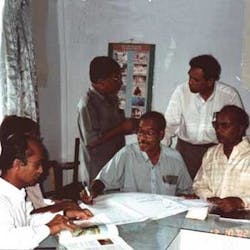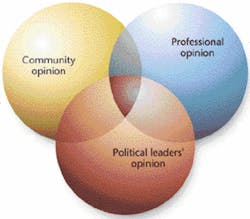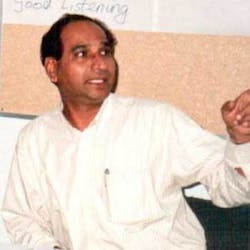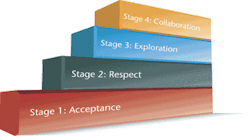Building stakeholder support for success
By Dr. Paul R. Holmes
Improving water and wastewater management requires community support; therefore the water sector needs more people trained to work with political systems, and to engage effectively with stakeholders to bridge the cultural chasm that divides.
Success in water and wastewater management in the 21st century needs more than professional expertise. As scientists and engineers, we like to think strict rationality controls what we do. We expect our legal and business arrangements to be firmly set in sound science, just as our treatment works and pipelines are. But being correct is no longer enough. We need the support of stakeholders too.
Unfortunately, people are not willing to accept what science, or the scientist, tells them. A catalogue of well-publicised instances ranging from cattle disease to the imagined threat of genetically modified "Frankenstein food" has created a perception: "experts" don't really know what they are doing and cannot be trusted anyway.
In a typical case of scientific confusion, miscommunication and misperception, a reputable newspaper reported a reduction in sewage discharges to the sea off the northeast coast of England. The report blamed this apparent improvement for starving a population of sea birds, including at least one endangered species. Different groups of "experts" with different agendas seemed to be working against each other, and the report made them look, collectively, foolish.
Water and wastewater management needs strategies to handle the challenge of the human factor. We need people in the water sector who are trained and equipped to work with political systems, and to engage with stakeholders across the cultural chasm that divides us. Technical problems are much easier to solve than these human ones.
Stakeholder support makes the water management organization or programme more effective in four ways:
- Agreement on what is to be done, especially where the stakeholders are powerful creates economy of effort.
- Agreement cuts the effort wasted in handling difficult relationships with stakeholders.
- The feeling of collaborative support motivates staff and managers to give their best performance.
- In many cases, stakeholders influence or control the resources, especially the money, needed to get the job done.
The professional needs to learn and modify or educate stakeholder opinions, so the outcome involves movement on both sides. This is more than a skill one can learn on a public speaking course or employ a public relations professional to manage. Rather, it means bridging the cultural gulf between people of entirely different intellectual inclinations - a gulf as wide as that between people of different races and nations.
Mindbridges
A suite of techniques called MindBridges can create effective relationships. Its three essential elements engage all parties in a process of equal give and take: active listening, cultural sensitivity and dynamic communication.
Active listening captures the message, the interests, beliefs and aspirations of the other party, however it is communicated. It means not just using the ears, but also the eyes and especially the brain. For example, some years ago I was working with an East Asian government to build a new capacity for environmental protection. Agency scientists produced ample scientific evidence of declining environmental quality, but the official line was to issue soothing messages, assuring the public that all was well. No one listened to the disbelief that echoed back from the public.
Only when I understood what the community did believe was it possible to admit what their own senses were telling them: pollution was a threat to everyone's health and well being, and we had to do something about it quickly. Once the government heard what the people wanted to know, and responded by telling them the truth, we gained deep community support and made rapid progress in tackling problems.
Cultural sensitivity is the cornerstone of MindBridges, not only for different national or racial cultures, but equally for any people with different ways of thinking and believing. Cultural sensitivity is a four-stage process to bridge across a cultural divide. Both sides need to be willing to meet, although neither should sacrifice the fundamentals of their own culture.
The first stage is to accept that a cultural divide exists, and it is not trivial. The second stage is to respect the norms and values of another culture, and their expression, as equally valid. This does not mean attempting, or pretending, to adopt or share the perspective of another culture. It can mean putting aside differences, rather than attempting to persuade someone to your point of view.
Stage three is to explore, finding out what you can about the other culture, how and why people believe, think and act as they do. This is a two-way process, sharing also your own beliefs respectfully without promoting them as better. The objective is to identify strengths in each that you can both use, and perhaps weaknesses for which you can compensate.
The fourth stage in the formal process is collaboration. This involves working together with people from the other culture, using the strengths of each, to achieve shared goals. You cannot reach this point without both sides being prepared to be flexible.
Cultural sensitivity should not lead to stereotyping. Values and behaviour may be chosen, may be widely different from group norms, and may change over time. Every individual should be treated as an individual.
It takes time, even using the four stages systematically, to build trust with people of a different culture. One of my favourite illustrations occurred when I was advising a department of another Asian government on its strategy. A small team of scientists, who had had little opportunity to develop their leadership skills despite the senior posts they held, had the job of collaborating to produce a strategic plan. They were very reluctant to show me their draft, expecting that, like their previous western advisers, I would rubbish their effort and shred them with it.
I could see at once that they had written their draft in a holistic, Asian style. Our western way of writing is like the way a painter paints a picture: background first, then foreground, finally small detail. This style fits well with our reductionist approach to science. The Asian style, in contrast, is like the way a photograph develops in a bath of chemicals: the whole appears at once, developing from a pale grey to progressively deeper tones as the picture becomes clear. This approach is well suited to success in business, where the quality of relationships is paramount.
With this insight I could see the strategy as the writers intended it, and spare my colleagues the criticism they didn't deserve. Their pleasure at my response made my own small cultural adjustment worthwhile. We went on to work together in a productive partnership that helped to pave the way for more effective service delivery in that country.
Dynamic communication engages the recipient in a search for understanding, appealing to listeners' values and interests in the language they use. Using pictures as well as words, stories more than facts and figures, one of the key premises is that the sincerity, energy and commitment of the speaker engage the listener more than words.
Scientists and engineers like to use facts and figures, but they often have no impact on people who think in different ways. The MindBridges approach deliberately appeals to audience emotions. We may reach people through their heads, but we change them through their hearts.
When promoting a big capital investment programme for water pollution control in a port city with 3.5 million inhabitants, I could have talked about the millions of litres of sewage we dumped into the harbour every day, the tonnes of BOD, and the resulting E. coli level in the water. Instead, knowing the unpopularity of pork meat in that community, I said the effect of sewage on the sea was like dumping 8,419 dead pigs into the harbour every day. The drama of that image, increased by the spurious accuracy of the number I used, punched home the message in a way that no amount of real fact and figures could have. So I won the support I needed in the community, and the government adopted the strategy.
Engaging the interest and support of the community is vital to improving water and wastewater management. The scientist or engineer who does it effectively gains influence and the power to change the future. Leaving the shelter of the plant or laboratory can be hard; many of us will not choose to try. For those who do, the rewards can be immeasurable.
Author's note
Dr. Paul R. Holmes FCIWEM MCMI of Mount Nicholson Consulting is located in Bicester, England, and invites readers to share their challenges and success in reaching out to people who think differently.Email: [email protected].




